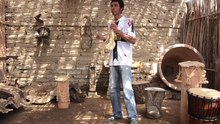Quijada
| Quijada | |
|---|---|
| english jawbone | |
| Quijada de burro | |
| classification | Idiophone |
The quijada ("pine"), also charrasca, cacharaina, charaina, carretilla or kahuaha , is a percussion instrument that is used in Latin American music . It's the lower jaw of a donkey, horse, or cattle.
The jawbone is boiled, dried and placed in an ant nest . The ants remove all remains of connective tissue so that the molars loosen and rattle in their tooth sockets.
The instrument can be played in two ways: in one technique, the instrument is held in one hand and struck with the other, whereby the teeth produce a typical rattle sound, in the other technique one rubs the row of teeth with a wooden stick. This playing technique is called carrasca .
It is played at folk festivals, carnivals and religious festivals. It is widespread in the Afro-Peruvian Música Criolla , in the music of the Dominican Republic , in the Mexican Son Jarocho and Son Afromestizo in the states of Guerrero and Oaxaca , in the Colombian Torbellino , in Guatemala , Belize and in the Chilean música chilota .
A modern variant is the Vibraslap .


